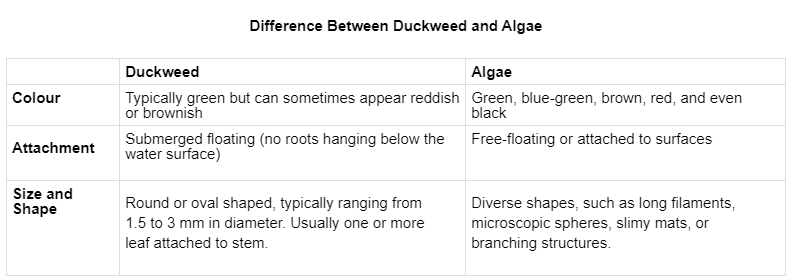The Difference Between Duckweed and Algae
Introduction
Both duckweed and algae can be found in nutrient rich and slow-moving or still water bodies. In many cases, algae and duckweed are found together in fast-forming and dense patches on the surface, making it hard to differentiate the two. In this blog post, we will help you identify duckweed and algae so that you can adapt your pond treatment strategies accordingly.

Separation Test
Place a stick in your water. Duckweed or blue-green algae will generally break apart when disturbed but algae generally stays together or may sink if disturbed. If it consists of tiny round leaves (1.5-3mm), you are likely dealing with duckweed.
Duckweed
Blue-green algae
Filamentous algae
Solutions
- Pond Pro sells a chelated copper-based algaecide that is effective for algae treatment. The chelated form of this product allows for a slower release of the algaecide (can take a couple days to break down), making it a highly efficient product. Please note that Pond Pro's algaecide has no effect on duckweed. Also note that if fish are present, you cannot exceed 3L/1 million gallons of water with this algaecide. Please ensure that you calculate the volume of your water body for accurate dosages (use Pond Pro’s calculator to help with this!) and if in doubt, treat conservatively.
- A good aeration system is the most important thing you can do to keep your pond free of duckweed. A large aeration system can even move duckweed to the edges of your water body, making manual removal easier. Pond Pro sells a variety of aeration systems for ponds, lakes, dugouts and lagoons.
Be sure to check these solutions out or contact our team at sales@pondpro.ca if you have any questions!
Recent Posts
-
Effortless RV Septic Maintenance: How SepticClear Keeps Your Tank Clean
How to Keep My RV Septic Tank Clean and FreshEveryone loves to take their RV out for a relaxing camp …11th Jul 2024 -
Clearing Pond Problems: Insights from Pond Pro's Product Experiment
IntroductionThe health and clarity of your pond is vital for both aesthetics and the well-being of a …17th Jun 2024 -
Treatment for Murky or "Iced Tea" Water
Treatment for Murky, “Iced Tea Water” in Ponds & DugoutsWe get multiple calls every summer of peo …3rd Jun 2024




